
Understanding your dog’s body language with other dogs

Philippa Short
12 March 2022 | 9 minutes read
You may not be able to speak woof, but you could learn to read what your dog’s body signals are telling you. And knowing this may just help you build a stronger and more trusting bond with your pooch. Expert dog trainer and behaviourist Philippa Short is here to guide you through the world of dog body language. Let’s kick things off with understanding canine body language during play with other dogs.
Table of Contents
- Why is reading dog play body language important?
> What things affect how a dog sees and reacts with other dog breeds? - Does a dog’s breed affect how they play?
> Are some dogs more playful than others? - What is appropriate dog play with other dogs?
> How to do a dog consent test
> How to teach your dog good play manners - How to read a dog’s body language when meeting another dog
> How to do on lead dog greetings safely
> Off lead dogs running up to on lead dogs
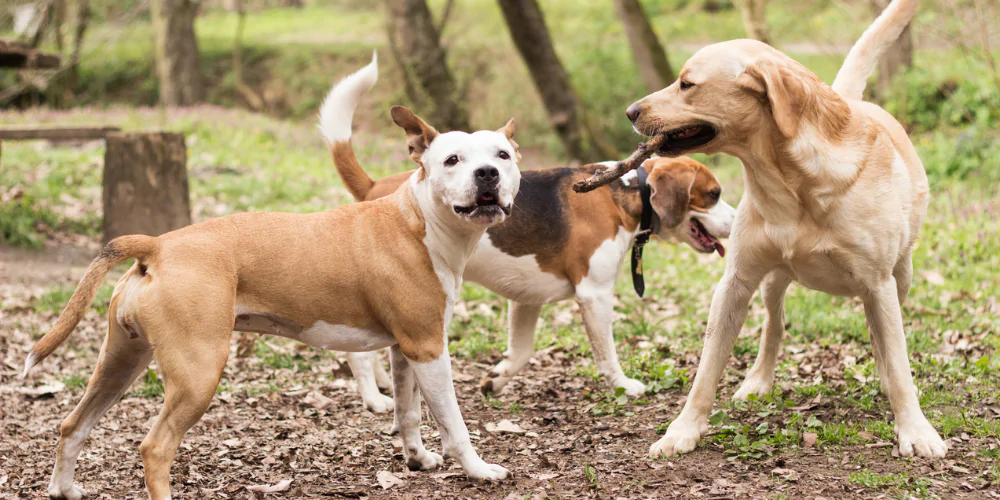
Why is reading dog play body language important?
Being able to read your dog and their body language (as well as other dogs) helps you understand if they are consenting to play. You can then tell if you need to help them get out of trouble in the early stages of playtime.
All breeds of dog have different ideas about how they’re going to play, based on the roles they were bred for. For example, herding and pastoral breeds have chase behaviours and bring nipping into play. While this doesn’t start as aggression, it could build into aggression from the other dog if they don’t use that same play language.
Always remember that all canines vary when it comes to play and body language. Teach your pup from an early age how to interact with a mix of breeds and sizes of dogs.
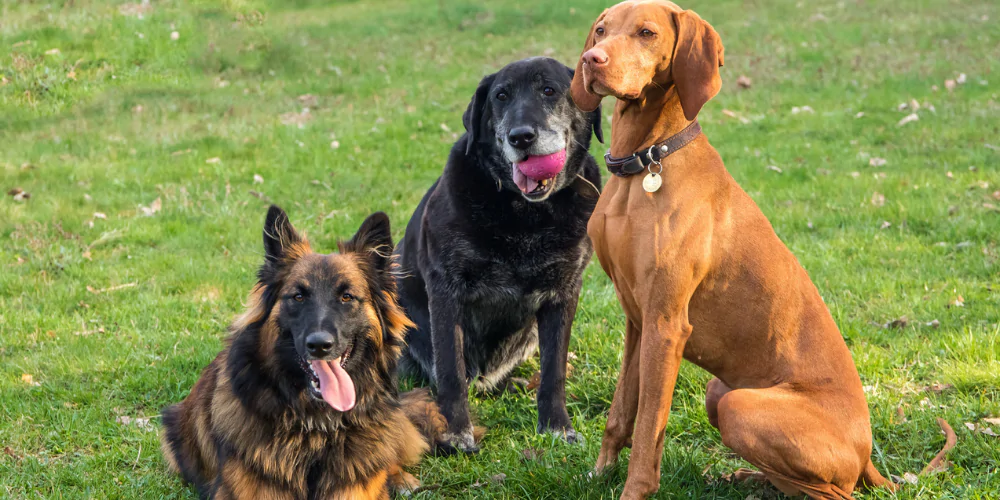
> What affects how a dog interacts with other dog breeds?
You might be surprised at just how many things affect how your dog sees another dog. It could be anything from:
- Size
- Hair length (makes it tricky for them to find the head)
- Head shape (flat nose breeds are hard to read)
- Noises (like snorting and wheezing)
- Tail shape (docked and bob tails are tricky to read)
- Colour (it’s hard for them to see the features of a black dog)
- Form (some breeds are built onto their forehands which can be intimidating)
- Ears (especially if they’re bigger and pricked up)
- Gender
- Neutered status (it’s a scent thing)
- Medical status (UTIs, anal gland issues, and phantom pregnancies can be very attractive and
- invite unwanted interest)
- Diet and medication
- Shampoo
It’s why socialisation is really important for your puppy, learning how to read and understand all the differences out there. But socialisation doesn’t mean free play with no rules and lots of dogs. Socialisation can be more natural, like:
- Seeing other dogs go by
- Watching them from a distance
- Sniffing them from a distance
Your canine learns to be calm and hang out with you, but can then appropriately greet another dog if they come over and decide to play.
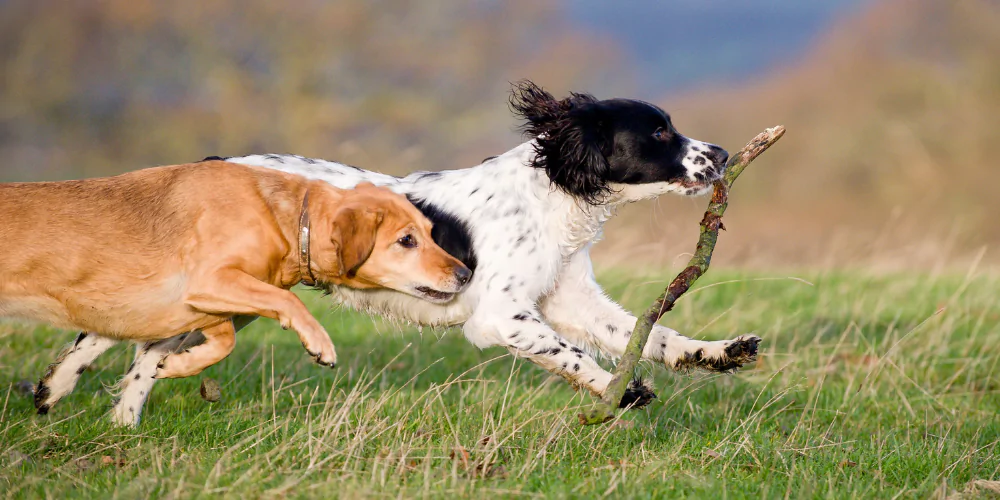
Does a dog’s breed affect how they play?
As we hinted earlier, a dog’s breed plays a big part in how they play and interact with other pups. To help make things easier, here’s a rundown of the main canine groups and what you might see in their body language during play.
> Gun dog play body language
Gun dogs often want to have something in their mouth, so they’ll try and involve a toy in their play game with others. These pups are super social and really enjoy their play sessions with other pooches.
> Herding dog breed play body language
Herding dog breeds regularly get into chase behaviours with other dogs. They may nip the back legs or bottoms of other dogs, or be slightly grabby around the neck. This is how they would control stock if they were doing their herding job, and so can be brought into play.
> Bulldog breed play body language
Bulldogs love to tug and will often use their body weight during playtime. Unless they have had some emotional training, they may body bump and thug other dogs.
> Hound play body language
Hounds like their chase games, and can either be aloof or playful, so stay alert! Playtime for this breed often means grabbing at the other dog’s neck and bringing them down.
> Labrador and Golden Retriever play body language
Labradors and Golden Retrievers are the party pups and can be a tad over-enthusiastic in their play. Teaching them gentle cues can really help them to adjust their energy levels.
> Poodle play body language
Poodles use their paws a lot in play and can be quite bouncy. They’re very light on their feet and can often outmanoeuvre many other dogs during get-togethers.
> Terrier play body language
The feisty Terrier can get over-excited quite quickly during playtime, with toys often shaken and disembowelled. They can become snappy, but this is down to getting overstimulated rather than being aggressive.
> Working and utility dog group play body language
The working and utility dog groups have a large mix of breeds, so picking out common body language signals isn’t as clear cut.
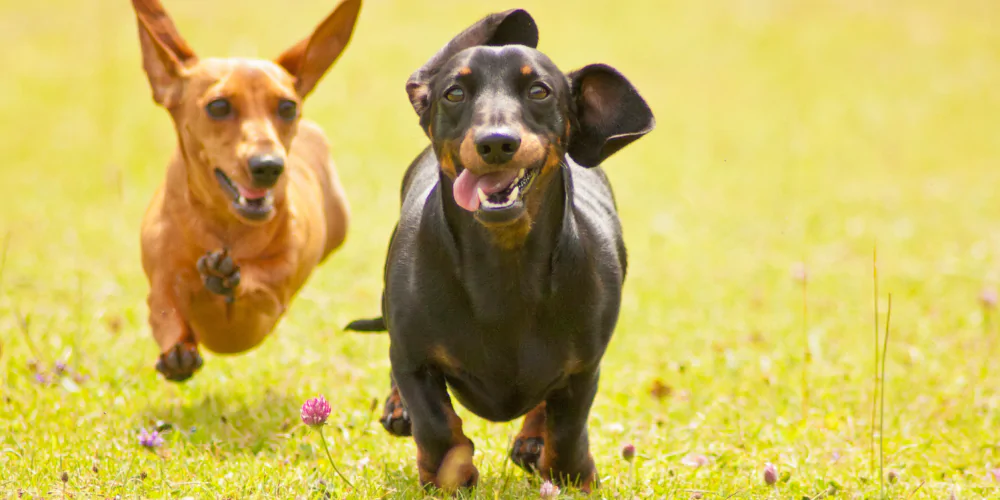
> Are some dogs more playful than others?
Similar to humans, dogs have individual personalities that make them party-goers (extroverts) or wallflowers (introverts). And it’s ok for your dog to be whoever they are.
If your dog is the more enthusiastic party type, you’ll want to help them slow down their behaviour. It’s so they can work the room (or should we say park?) better with other canine personality types.
Introduce words like gently, steady, and slowly, with lots of rewards for measured behaviour. You might find your dog does this automatically because they can tell when they need to tone down their play.
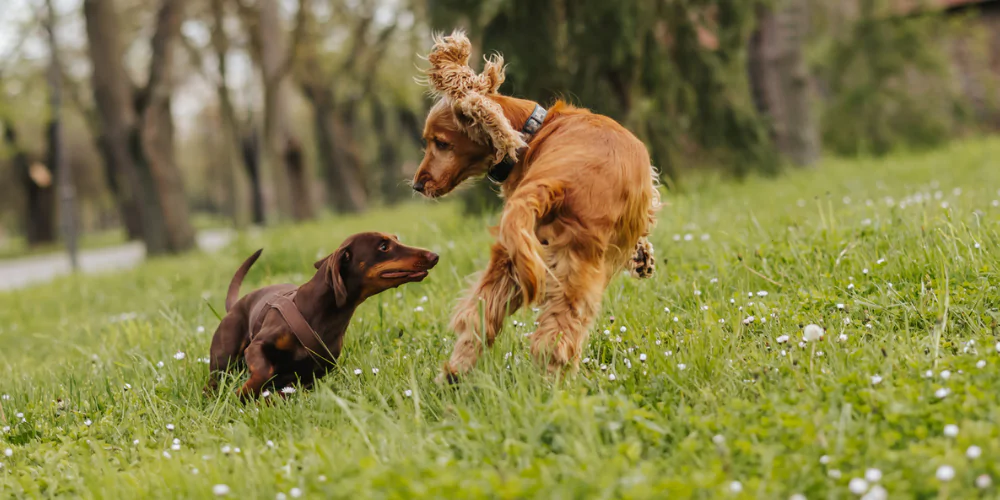
What is appropriate dog play with other dogs?
So, how exactly do you know when your dog is playing appropriately with others? Well, good play is equal between both dogs.
Let’s take a game of chase as an example:
- Your dog runs after another pooch for 10 seconds.
- Both dogs come to a natural stop.
- The other dog then turns and chases your dog for 10 seconds.
- This equal switching carries on through playtime.
The same is true for more rough and tumble play. If one dog is on top more than the other, then play might not be equal and consensual.
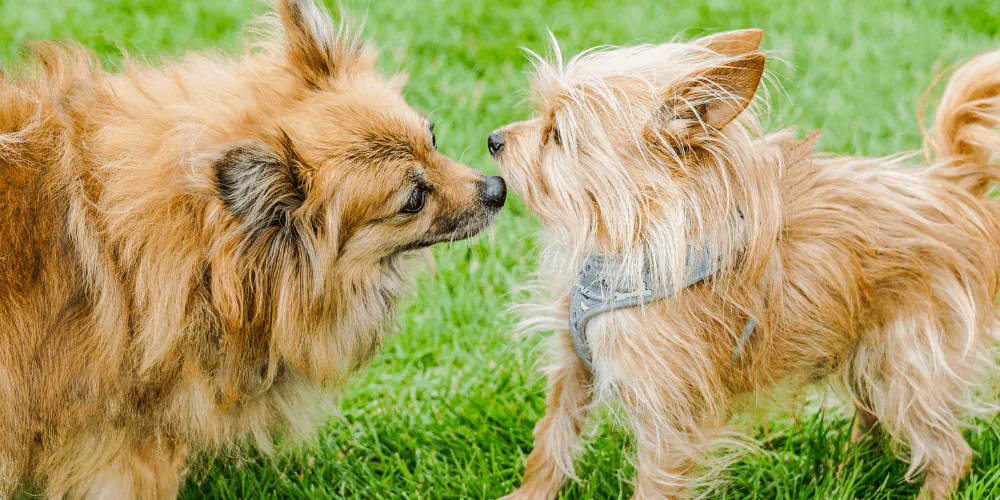
> How to do a dog consent test
If you’re ever in doubt if play is equal, you can do a consent test:
- Quietly interrupt play by calling your dog over.
- The owner of the other dog does the same.
- Reward your dog for coming back to you and wait to see what they do.
- If both dogs choose to go back to play, then you know they’re consenting.
- If either dog stays where they are, you know to bring playtime to a stop.
Some dogs don’t mind being the more passive pooch during rough and tumble play – but you’ll always want to check this with a consent test. If your dog seems to be on top more often:
- Quietly go over and gently lift off your dog.
- Bring your dog at least two or three feet away from the other dog who was underneath.
- If the other pup shakes themself off and walks away, they’re telling you they weren’t comfortable with the play.
- If they get up and decide to come over to your dog, you’ll know they’re happy being the underdog in the rough and tumble.
The key thing here is to regularly check in during active play. The dynamic between your dog and the other could change at any moment, and it takes seconds to do a consent test. When done well, it isn’t a form of punishment for your pooch. It allows smooth and easy relationships with other dogs.
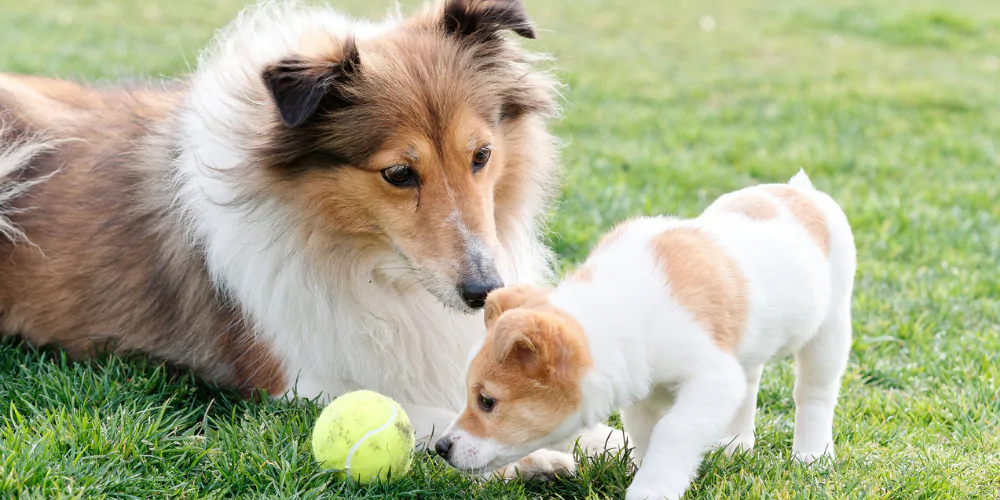
> How to teach your dog good play manners
As we’ve learned from positive reinforcement training, anything that’s practised becomes a habit. So you don’t want your puppy or adult dog practising unwanted behaviours in play. What an 11 week old puppy gets away with during play, might cause a fight when they’re 11 months old and much bigger.
A few ways you can help your dog learn good play manners include:
- Teaching them calm down cues such as ‘steady’ and ‘gently’
- Getting them used to regular consent tests
- Actively watching their interactions with other dogs
Your dog may be a party-goer and could be making a wallflower pup feel uncomfortable or threatened. While your enthusiastic canine may have impeccable manners, they should be reading the other dog’s discomfort. If they can’t do this, you need to be ready to call them back to you straight away. This could help stop another unhappy or unsocialised dog from snapping or fighting with your pup.
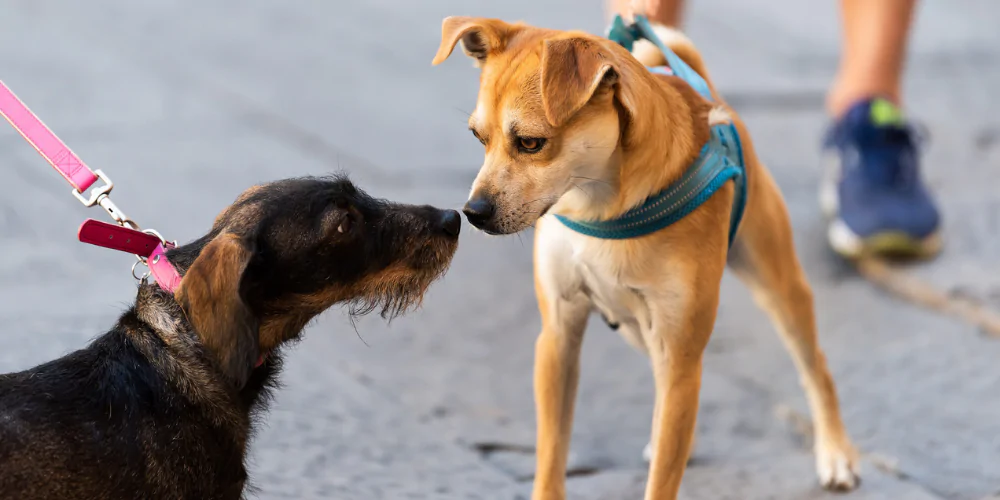
How to read a dog’s body language when meeting another dog
So now you know about play manners, what about body language when your dog meets another for the first time? Leashed dogs can feel more defensive because they cannot flee if needed. This is why it’s not always a good idea for canines to meet on a lead. But sometimes your environment means on lead greeting could happen, for example in town centres or at the vets.
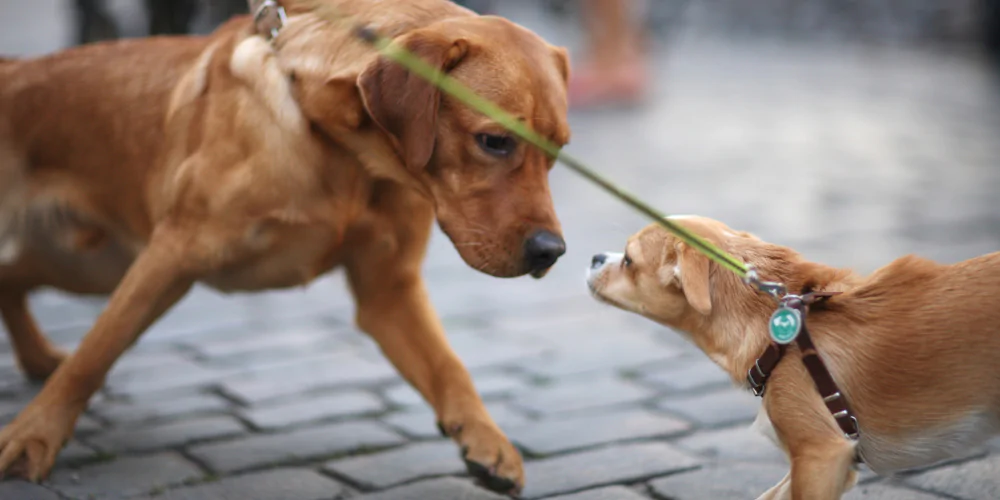
> How to do on-lead dog greetings safely
To help keep on-lead greetings safe for both leashed pups, you can do a lead consent test:
- Let your pooch go up and say hi, watching both dogs’ body language.
- After three seconds, call your dog away, even if the interaction seemed friendly and happy.
- Wait and see if both dogs would like to go back and see or sniff each other.
There’s a few key points to keep in mind here:
- Time is crucial – three seconds is long enough for a ‘handshake’
- Taking each dog away lets them emotionally process how they feel about each other.
- If both dogs consent, they can have another chat
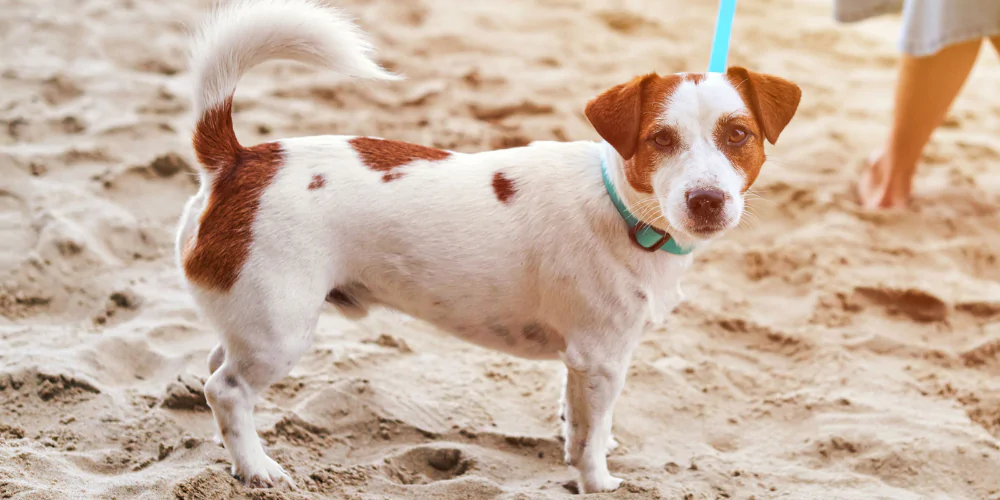
> Off lead dogs running up to on-lead dogs
It’s really important to not let your off lead dog run up to an on-lead dog. The other dog could be:
- In season
- Elderly
- In pain
- Recently out of the vets
- Grumpy, frightened, or aggressive
You don’t know why they’re leashed, so don’t risk it. The other owner will tell you that it’s safe for your dog to say hello (for example, their dog may be on lead due to bad recall). Make sure your dog has a good recall when off lead, otherwise use a long line and keep practising the cue.
Help keep your playful dog happy and healthy with flexible dog insurance from Petsure.


